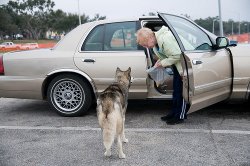The Differences Between Cats and Dogs
We could spend years debating why are cats and dogs different? But, the answer is easy… they are different species. While it can take weeks to train a cat to “come” or “sit”, dogs can learn this behavior in just about five minutes. On the other hand, cats learn to use a litter box with almost no training, but it can take tons of persistence to do the same with a small dog. It’s obvious that what’s important for dogs is not important for cats and vice versa. 
The main difference is this: dogs are pack animals; cats tend to be more independent, though not solitary animals as some perceive them.
Dogs are social creatures and are happy and content in a group situation.
If an owner provides proper leadership, he or she becomes the pack leader and the dogs will view them with respect. However, if they are treated badly, they will still remain in the pack because they are attached to their people.
Cats form groups, but there is not a structure of leadership. They are very territorial but they will share their territory, as long as their needs are met and they’re not treated badly.
Dogs normally attach to its group, and not their surroundings. You can take your dog to work with you or move to another house, and the dog will be happy as long as he’s with you. Although cats also get attached
to people, if you take your cat away from its regular surroundings, he or she will develop fear and anxiety.
Dogs learn everything from observing other pack members. They learn by interacting with their owners.
When the leader uses rewards to get behaviors that will ‘group the pack’, such as “come” or “sit”, dogs respond promptly. It’s embedded in their DNA. Dogs can be trained because they desire to please their owners.
Cats…. well, it’s not the same with them.
Dogs also learn what not to do when another member of the pack growls or snips at them. The dog will avoid repeating the situation, especially to please a high ranking member of the pack. That negative reinforcement works with dogs, but a cat, will avoid the source of the punishment, clearly, their owner, so punishment will not work on a cat.
 Picture a hunting situation in the wild with a cat: she goes out hunting alone, stalks her pray, and in case of danger, she can jump and climb to get away. Now picture a dog in the same situation. He follows his pray through scent, but he’s not very stealthy. If confronted, he will have to fight. Dogs use fighting to defend themselves; cats are agile enough to escape. The concept of ‘flight or fight’ is very important for dogs. That’s why hunting in a pack is what’s effective for them.
Picture a hunting situation in the wild with a cat: she goes out hunting alone, stalks her pray, and in case of danger, she can jump and climb to get away. Now picture a dog in the same situation. He follows his pray through scent, but he’s not very stealthy. If confronted, he will have to fight. Dogs use fighting to defend themselves; cats are agile enough to escape. The concept of ‘flight or fight’ is very important for dogs. That’s why hunting in a pack is what’s effective for them.
What does all this mean?
The difference between cats and dogs can be summarized beautifully with this statement: “My dog looks at all the things I provide for her and says ‘You must be God.’ My cat looks at all the things I provide for him and says ‘I must be God’”.
What to do if You Find a Lost Pet
What do you do if you are driving and all of a sudden you see a dog or a cat roaming alone on the street? If you’re an animal lover, I know this is a heart wrenching situation. Do you rescue it or not? If you decide against it… at least call animal control and give the details of where you saw the animal. You will at least be giving it a small chance of getting rescued.
But, put yourself in the original owners place and think what you would want the finder of your animal to do if he found him hurt or without his collar.
 If you’ve never lost a beloved animal you might think that the owner of the found dog or cat abandoned him or neglected to keep him safely confined. But accidents can happen. The frantic owner could be looking everywhere for their pet.
If you’ve never lost a beloved animal you might think that the owner of the found dog or cat abandoned him or neglected to keep him safely confined. But accidents can happen. The frantic owner could be looking everywhere for their pet.
If you decide to rescue it:
Stop for a bit and observe the animal. Does he have a collar? Is he acting scared? Does it look hurt? If you decide that it’s lost, be careful. Not all dogs and cats are friendly, and a hurt animal can be aggressive. Open the back door of your car slowly, as not to startle him or her and call it over… if it comes on its own, great. Don’t try to force it or approach him too fast. Speak softly and try to reassure him. If you’re not able to restrain the animal in a safe way, call the local police or animal control agency.
If you are able to capture him, check for a collar or an ID chip. If you are lucky, he’ll have one and you can call immediately. Otherwise, your first stop should be an animal hospital. They can check for a microchip and find the owners if they find one. If you are planning on taking him or her home, ask the animal hospital to give you flee treatment that you can give right away. If it’s hurt, be ready to take the financial responsibility of his care. If you’ve already made up your mind to take him home, a full vet’s checkup is a good idea, but you have to be willing to pay for it.
That’s the toughest decision: will you take it home or will you take it to the humane society or a shelter? Unfortunately, most animal agencies don’t have the budget to sustain many animals at a time, and most of them euthanize strays in a few days. If you take the animal there, ask for a case number and make sure you leave your information. Make sure to call everyday and see if the owners came forward, otherwise, be ready to take him out before they euthanize him. You can tell them you are taking him home, but it’s important that they know you have the animal, since that is the first place the owners are going to look.
Taking him home will give you a whole new set of responsibilities. You will have to bathe and feed him or her. Be careful with you other animals. You don’t know if this found animal has had all its shots and might put your own pets at risk, so try to keep it separated until you get it checked. Sometimes you can tell by the appearance of the animal if he was lost recently and how well it was taken care off. Is it groomed? Clean? Are his teeth clean? Use your judgment. But remember that if it’s been lost for many days, it won’t look very pretty, so don’t assume it was mistreated or abandoned. The most beloved pets sometimes get out and get lost.
Now it’s time to take pictures. Colored posters work best. Don’t give out every detail of the animal, so you can weed out the real owners. Say it has a collar, but don’t say what color, etc. Post the signs around the area where you found it and a little beyond. Take the poster to different shelters in the area, vet offices, grooming facilities, etc. Use Craigslist! You can post the picture for free. There are many Lost Pet websites where you can register the animal. Call the newspaper. Posting a lost pet announcement is not that expensive. Do you best to find the owners. It can take some time.
Think about what to do while you look for the owners
Can you keep it in your home? Are you willing to return him to his original home if the owner turns up after a while? Can you find him a temporary home until you find the owners? How about a permanent home if you are not lucky in your search?
Check with the ASPCA, the Humane Society and other animal agencies in you area to find out the guidelines about lost and found pets. They can give you more ideas. But all in all, if the animal stays with you while you find its owners, they stand a better chance of surviving. It might be a little costly to be a Good Samaritan, but there are many clinics and agencies that might be willing to help. After all, isn’t it worthwhile to save a life?
What do you do if you are driving and all of a sudden you see a dog or a cat roaming alone on the street? If you’re an animal lover, I know this is a heart wrenching situation. Do you rescue it or not? If you decide against it… at least call animal control and give the details of where you saw the animal. You will at least be giving it a small chance of getting rescued.
But, put yourself in the original owners place and think what you would want the finder of your animal to do if he found him hurt or without his collar.
If you’ve never lost a beloved animal you might think that the owner of the found dog or cat abandoned him or neglected to keep him safely confined. But accidents can happen. The frantic owner could be looking everywhere for their pet.
If you decide to rescue it:
Stop for a bit and observe the animal. Does he have a collar? Is he acting scared? Does it look hurt? If you decide that it’s lost, be careful. Not all dogs and cats are friendly, and a hurt animal can be aggressive. Open the back door of your car slowly, as not to startle him or her and call it over… if it comes on its own, great. Don’t try to force it or approach him too fast. Speak softly and try to reassure him. If you’re not able to restrain the animal in a safe way, call the local police or animal control agency.
If you are able to capture him, check for a collar or an ID chip. If you are lucky, he’ll have one and you can call immediately. Otherwise, your first stop should be an animal hospital. They can check for a microchip and find the owners if they find one. If you are planning on taking him or her home, ask the animal hospital to give you flee treatment that you can give right away. If it’s hurt, be ready to take the financial responsibility of his care. If you’ve already made up your mind to take him home, a full vet’s checkup is a good idea, but you have to be willing to pay for it.
That’s the toughest a decision: will you take it home or will you take it to the humane society or a shelter? Unfortunately, most animal agencies don’t have the budget to sustain many animals at a time, and most of them euthanize strays in a few days. If you take the animal there, ask for a case number and make sure you leave your information. Make sure to call everyday and see if the owners came forward, otherwise, be ready to take him out before they euthanize him. You can tell them you are taking him home, but it’s important that they know you have the animal, since that is the first place the owners are going to look.
Taking him home will give you a whole new set of responsibilities. You will have to bathe and feed him or her. Be careful with you other animals. You don’t know if this found animal has had all its shots and might put your own pets at risk, so try to keep it separated until you get it checked. Sometimes you can tell by the appearance of the animal if he was lost recently and how well it was taken care off. Is it groomed? Clean? Are his teeth clean? Use your judgment. But remember that if it’s been lost for many days, it won’t look very pretty, so don’t assume it was mistreated or abandoned. The most beloved pets sometimes get out and get lost.
Now it’s time to take pictures. Colored posters work best. Don’t give out every detail of the animal, so you can weed out the real owners. Say it has a collar, but don’t say what color, etc. Post the signs around the area where you found it and a little beyond. Take the poster to different shelters in the area, vet offices, grooming facilities, etc. Use Craigslist! You can post the picture for free. There are many Lost Pet websites where you can register the animal. Call the newspaper. Posting a lost pet announcement is not that expensive. Do you best to find the owners. It can take some time.
Think about what to do while you look for the owners
Can you keep it in your home? Are you willing to return him to his original home if the owner turns up after a while? Can you find him a temporary home until you find the owners? How about a permanent home if you are not lucky in your search?
Check with the ASPCA, the Humane Society and other animal agencies in you area to find out the guidelines about lost and found pets. They can give you more ideas. But all in all, if the animal stays with you while you find its owners, they stand a better chance of surviving. It might be a little costly to be a Good Samaritan, but there are many clinics and agencies that might be willing to help. After all, isn’t it worthwhile to save a life?
Photo Courtesy of:
How to Make Your Cat Love Getting Groomed
Regularly grooming your cat can help reduce hair ball problems and can ensure that your cat’s coat continues to look healthy and beautiful. However, not all cats enjoy getting groomed. Some love being brushed and can even get a little bit demanding about their regular grooming time. Geisha, my long hair calico is very vocal about this…. trust me. Others would prefer to keep their distance from the brush permanently.

Tisha and her Zoom Groom
So, grooming a cat can be difficult. But even a resistant cat can be taught to enjoy grooming. The key is to utilize the cat’s enjoyment of human contact. The most aloof cat enjoys some great periods of petting, but some have parts of their body that are more sensitive, and they don’t want to be touched, especially not with a brush.
Understanding Your Cat’s Reluctance
Before you can change your cat’s negative attitude towards grooming, you need to understand what causes it. First, you should realize that cats, just like people, have sensitive parts in their bodies. The cat may have been injured at some point or maybe just does not like being touched in a specific area. This is why it’s important to know your cat before you begin grooming. If you know which parts of your cat’s body are sensitive, you can avoid those areas and still provide what he or she needs.
If you bring a new cat home that hasn’t had a lot of grooming before, you may want to work slowly and get her used to it. Spend a few minutes each day stroking or brushing your cat gently and make sure to give her some type of reward afterward. You want her to think the grooming is pleasurable. Avoid any trouble spots as much as possible, too.
Another issue that might cause your cat’s reluctance to submit to grooming is a dominant personality. When cats have dominant personalities, they might refuse to let you touch some parts of their body touched as well, particularly the head and neck. Now, if you’re not sure whether your cat is resisting because he or she is nervous or dominant, think about some of your cat’s other traits:
- Does the cat make direct eye contact with you?
- Does your cat jump on people as a way of showing affection?
- Does your cat not like to be in a “down” position?
If you answered yes to any or all of these questions, your cat is probably dominant.
As I mentioned above, the key here is to help your cat enjoy being groomed. To do this, you have to first figure out how long your cat takes to get upset by your actions. Pay attention to his body language. As soon as you start feeling him get tense, stop. The key is to spend a small amount of time doing the grooming, and stopping just before your cat passes that threshold, this way, you can continue showing him that grooming is a pleasant experience.
Here are a few additional tips to help your cat love being groomed:
- Do the grooming sessions before feeding your cat so you can use the food as a reward and as a way to bond with your cat
- Let the cat play with the comb if he or she wants to
- Alternate brushes with the comb and strokes with your hand to help your cat feel more at ease
- Set your grooming sessions in the afternoon when your cat is most relaxed
- Talk to him or her while you brush, this will also serve as a bonding experience.
Pick the Right Tools
There are a number of brushes and combs on the market designed specifically for cats, but some of these tools can be quite painful for them, despite what it says on the packaging. Using them can make a reluctant cat even more fearful of grooming. A long hair cat might adore being brushed with a wire brush, but a short haired cat might prefer a grooming glove (my short hairs absolutely love the glove!).All of them, long and short haired, love the Zoom Groom!
Whichever brush they choose, you will be doing your cat or cats a favor if you get them used to getting groomed often. It will make them look beautiful and help them with any hairball problems they might have.
Advantages of Obedience Training
When you bring home a new puppy or dog, especially if you are a first time dog owner, it’s a good idea to sign up for obedience classes.
It’s important that your dog has good manners. That means he or she needs to learn some basic commands: sit, stay, come, down, and others. By teaching your dog these commands, you should have more control over him or her during social situations.
When attending obedience classes, you will have a good opportunity to begin developing the appropriate roles for you and your dog. You love your canine companion, but that doesn’t mean you shouldn’t let him or her know who is in charge in the relationship. After all, you love your children but you let them know you are in charge.
Another reason to consider obedience classes is the socialization you can achieve. Most obedience classes involve group classes. This gives the pet an opportunity for socializing in a controlled environment and also gives you a chance to practice the commands when a lot of distractions are present.
In some cases, obedience trainers may be able to offer some strategic suggestions for dealing with common puppy or dog behavior problems, such as barking or chewing.
Don’t rely on the obedience classes alone
While an obedience program can help you learn useful commands to use with your dog, a lot of people who complete these training programs get lazy after finishing them. They don’t consistently use those commands once training is finished. Without following through, the training is useless.
 You need to make sure you continue working with the commands on an ongoing basis… 5 to 15 minutes a day is all it takes to really drive home those commands.
You need to make sure you continue working with the commands on an ongoing basis… 5 to 15 minutes a day is all it takes to really drive home those commands.
Keep in mind that sometimes obedience programs don’t allow the dogs to learn at their own pace. While most dogs can pick up on commands relatively quickly, some commands or tricks may take longer to learn for some dogs than others. For example, some dogs are very resistant to the “Come” command while others have no trouble mastering it in a short time. So if your dog doesn’t pick up on something immediately, make sure you practice that particular command often until they learn what they need to know. Once the obedience classes are over, keep training on your own, you can work at your dog’s pace and can save both of you a lot of frustration.
If you decide to use obedience program, research what kind of training that particular group uses. They are not all created equal. You also want to make sure the program provides socialization time. Even though this is one of the best reasons to go through an obedience program, not all of the providers offer this option. Always ask before you sign up. Keep searching until you find one that truly serves your needs.
Always remember that your dog loves to learn, and one you learn how to teach him something, it will be a breeze to teach him anything you want. You will have fun together and a wonderfully behaved dog!
Why Does a Cat Stop Using the Litter Box?
While cleaning out the litter box is not a wonderful chore that anyone enjoys, it is a necessity for your cat. This is, after all, your cat’s bathroom area and cats have a tendency to be very fastidious. If your cat suddenly starts having litter box problems and using the bathroom elsewhere, this might be a sign that you need to be cleaning that box more often. However, it can also be a sign of other problems, including serious medical conditions.
Reason #1: Busy Location
Cats are private animals. While a dog will do its business outside with everyone in the world watching and think nothing of it, cats have to relax in order to get the job done. If the litter box is located in an area where people are always coming and going, that’s going to be upsetting to your cat and he or she is likely to go elsewhere in the house, usually some place quiet like a corner.
Now, if you haven’t moved the litter box and if the traffic in the area hasn’t increased lately, but your cat has suddenly stopped using it, there’s probably another good reason.
Reason #2: Cat Preferences
Cats seem to be a lot pickier than dogs about everything from toys to food to sleeping locations. They are also sometimes very picky about their litter boxes. Many cats like certain types of litter better than others, possibly because of the way it feels on their paws. Other cats have litter box type preferences. While some love to have the covered boxes for more privacy, others prefer something that is a little more open so they can what is going on around them.
As with the first reason, if you haven’t made any changes that might upset your cat’s preference but he or she has suddenly stopped using the litter box, there is probably a different reason as the root cause.
Reason #3: Medical Problems
In some cases, a urinary infection or some other health problem can cause cats to have litter box problems. They may have a hard time going to the bathroom or may associate the litter box itself with discomfort which makes the box undesirable. If the sanitary reasons and the first two reasons don’t seem to explain the sudden change in your cat’s behavior, you should seek advice from a veterinarian immediately. Your cat might have a very serious health problem.
If you cat is defecating outside the litter box, he or she may have worms, gas, or other intestinal distress so a vet visit is definitely recommended. Remember that once your cat starts using the bathroom outside of the litter box, cleaning it with a solution that will destroy the enzymes in the urine or feces is essential. Otherwise your cat is going to continue to view that spot as an appropriate choice for going to the bathroom.

Amanda
Reason #4: Behavioral Problems
If you’ve ruled out all of the other reasons, you’ll have to start thinking like your cat and trying to pinpoint what may be the real problem. Anxiety can be one reason. A cat that doesn’t like to be left alone may use the bathroom outside the litter box as a sign of separation anxiety. A cat that’s angry because a new family member or pet has come into the picture may also start protesting by not using the litter box correctly.
When emotional issues are involved, you may find it harder to pinpoint the cause. However, you may be able to work with your vet on figuring out the best way to solve the problem so your cat can start using the litter box again and you can cut down on cleaning the carpet and other areas of your home.
Unfortunately, it’s very hard to fix a behavioral problem if you don’t know the exact cause. However, with patience and love, you might be able to find the cause and fix the problem. Sometimes medication can help. Do your research before taking any drastic measures. Always remember that no matter what he or she does, it’s not done to spite you. Cats are not capable of those ‘humanoid’ feelings. If your cat is having litter box problems, he doesn’t deserve to be punished or God forbid, euthanized, just because we don’t understand his reasons.
Crate Training An Older Dog
You bring home your new canine friend and now it’s when the work begins. While it would be wonderful to cuddle with him or her forever, and just play and enjoy him, this is the time to housebreak him and the best way to do this is with the use of a crate or doggie den. And it doesn’t matter if you bring home a young or an adult dog.
You dog won’t hate you for putting him in a crate if you do it right.
Crate training is based on the idea that dogs carry many of the same instincts as their ancestors, including wolves and wild dogs. Two of those instincts are not to go to the bathroom in your living area and to have a small living area that will offer you protection (aka a den). In the wild, animals do not use the bathroom near their living quarters probably because they realize at an instinctual level that doing so is unhealthy and because the odor is going to attract predators. In the wild, you also want a safe and cozy place to call home.
The crate allows you to use these two instincts to potty train your new pal. The crate acts as the protective den for the dog. He or she may not enjoy it at first, but will eventually come to see it as a place of safety and peace. Because the dog is also going to be considering it a den, she’s not going to use it as a toilet either.
How Does it Work?
Confining your dog for a while allows you to sort of predict when he wants to go, so you will be there to take him directly to the appropriate spot and reward him handsomely for doing the right thing in the right place. Once he’s used to going to that spot, the crate won’t be necessary, but it will remain there for him to hide or have quiet times, or you can use it to travel and take him places, knowing he’ll be comfortable inside his little den.
What Kind of Crate to Use?
There are different types of crates for dogs available. Some are made from metal and are more open so the dog can see around him. Others are made from hard plastic and have a metal door on the front. The latter is the type used to fly your dog on an airplane.
Regardless of which type you choose, you want to get a crate that is only large enough for your dog to stand, lie down and turn around in. You don’t want to have too much extra room or else the dog can use part of the crate as a bathroom and defeat the entire purpose.
Associate the Crate with Positive Things
Don’t assume your dog is going to recognize immediately that the crate is his or her new den. You’ll have to make the dog associate being in the crate with something positive, such as tasty treats, favorite toys, and lots of praise. Do this very slowly and avoid leaving the dog alone in the crate for too long before he has become accustomed to it. Negative experiences will make the whole process take longer.

Emanuelle
You should also give no affection or attention to the dog if she’s whining in the crate. Your natural impulse will be to comfort her but this will only make things worse. Also, do not let her out of the crate until she’s quiet. Otherwise, you’ll be rewarding an undesired behavior.
You should put the crate in an area where your family or yourself spend a lot of time, never put it in an isolated place. Put a cushion or a soft blanket inside. Now bring your dog over with lots of praise and a playful tone. Open the door of the crate and secure it so it won’t close accidentally.
Now, she has to go into the crate on her own, so encourage her with treats. You can drop some just outside, and leave a trail up to the back of the crate. The goal is to make her go in on her own. This can take a while, so be patient and never force her!
Once she goes in once, you can try to start feeding her right next to the crate, and slowly move her dish all the way to the back of the crate. Once she’s comfortable eating all the way inside, start closing the door while she eats and opening it as soon as she’s done.
Every time you do this without her getting anxious, increase the time you leave the door closed. If she starts whining, maybe you left it closed too long. Try shortening the time the next time.
But remember: do not open the door when she’s whining or you’ll ruin everything!
Once she’s used to that, start calling her and giving her a treat to go inside. Close the door and stay with her 5 to 10 minutes, then to another room for a few minutes, return and sit quietly a little while longer. Do this a few times a day if possible.
When your pal is used to the crate, start feeding her inside and then wait an hour or so to take her out after her meal, and take her to her potty spot. Wait until she goes. And when she does, give her a treat and then take her for a walk! The walk will be her reward! If you walk her first and then you take her inside after doing her thing, she might get the idea that her walk is over when she goes and you can seer the problem there, right?
This is perfect especially for dogs that live in apartments. They can learn to go on their potty tray, and then the walks are just the icing to the cake! Whatever your circumstances, give crating a try.
Welcome to Your Pet’s Universe!
All Articles
CAT ARTICLES
What to Expect With Cat Diabetes
Congratulations, you have a pregnant cat!
How to Prevent Nasty Hairballs!
Learning to Coexist With a Trouble Making Cat
How to Make Your Cat Love Getting Groomed
Why Does a Cat Stop Using the Litter Box?
Good Reasons to Keep Your Cat Indoors
Neutering or Spaying Your New Kitten
Mistakes New Cat Owners Shouldn’t Make

DOG ARTICLES
The Most Dangerous Dogs in the World
The Incredible Wolf-Dog Hybrid
Keep Your Dog Cool Under Extreme Heat
Why Was There Blood in my Dog’s Stool?
When Does Your Dog Need to See a Vet
Advantages of Obedience Training
The Benefits of Using a Dog Park
Neutering or Spaying Your New Dog
How to Control your Dogs’ Submissive or Excited Urination
OTHER INTERESTING ARTICLES
How To Apply CPR To A Dog Or Cat
Yes, You Can Talk To Your Pets
Should I choose a dog or a cat as a pet?
The Importance of Good Dental Care for Your Pets
The Differences Between Cats and Dogs
To Rescue or Not: What to do if You Find a Lost Pet
Can You Live a Life Without Pets?
 PET ADOPTION ARTICLES
PET ADOPTION ARTICLES
Are You Really Ready to Adopt a Pet?
Top Five Reasons to Adopt a Pet
Adopting from an Animal Shelter
The Awful Reality of Puppy Mills
TOP TEN FACTS ABOUT…
Grieving the Loss of Your Pet
Our pets live rather short lives, so it’s inevitable that at one point we have to go through the grief of losing one of our best friends. The pain is very intense… don’t let any one make you feel silly or over sentimental. I know that when I lost Pucci, my Pomeranian, my constant companion for 15 years, I felt an emptiness in my chest that still comes back whenever I think of him over three years later. Tears come to my eyes whenever I remember his last day and how difficult it was to say goodbye. In 2010, after a very normal morning, Geisha started meowing excessively. I took her to the vet and had to put her to sleep that same afternoon. I still cry almost every day almost a year later.

Pucci 1993-2008
People who don’t understand the bond one can develop with a pet may not understand your pain, but what matters is how you feel. Your feelings are very valid.

Geisha 1995 – 2010
When you loose someone important in your life, grief is the normal response. When you grieve, you experience physical and emotional pain as you try to adapt to the loss. The grief that you suffer when you lose a pet has been recognized by psychologists to be the same as that experienced after the death of a person.
THE FIVE STAGES OF GRIEF AND… EVERYTHING ELSE
There is a lot out there about the five stages of grief, so I will describe them as well, but then, there are a lot more feelings that come that might confuse us even more as we go through them, but you have to recognize that these emotions are perfectly normal.
Guilt: You might feel responsible for your pet’s death, particularly if you had to euthanize him or her.
You may think you could have been more careful, taken better care of him… even that maybe it wasn’t necessary and you could have saved him.
Denial: You have not accepted the reality of the death. You might feel it is unreal. You will see him out of the corner of your eye.
Anger: The grief might make you lash out at your family, your friends, the Veterinarian or the world in general. During this stage you might also feel guilt or fear.
Depression: This is a normal reaction created by the loss. You will feel intense sadness, drained and helpless. You will miss your life with your pet.
Acceptance: It will come when the changes brought upon by the loss are stabilized into your new lifestyle.

Tisha 1996 – 2014
But then, you might also feel shock, anxiety, exhaustion, numbness, helplessness, fear, sorrow, despair, abandonment and loneliness, irritability. You might also feel it physically with muscle weakness, aches and pains, shortness of breath, tightness in the chest, dry mouth, lethargy, a sense of detachment from everything else around you.
You might have trouble sleeping, have nightmares, or you might sleep too much.
When Pucci died I found myself treasuring even the hair on his brush, and I would hug every blanket he had slept on. If, on the other hand, you feel that having reminders of him or her hurt you, do yourself a favor and put everything in a box. Don’t throw anything away yet.

Misha – 1996 – 2012
Don’t feel bad for wanting to stay home and think about your lost pet, or for wanting to be out and about so you won’t have to be home and think about it. The intensity of the mourning process depends on many factors and nothing you feel can be considered abnormal.
Your age, the circumstances surrounding the death, the age of the pet, your relationship with the animal, are all things that will somehow affect your mourning process.
The most important thing to do is acknowledge your feelings. Do not hide your pain or try to be brave. Cry, scream, pound the floor, talk it out. Seek people that will understand what you are feeling. Ask your vet for information about bereavement groups. You are not alone.
Let your friends know what happened and talk to them about it. Some people find it useful to write about their pets, prepare a memorial of some sort, like a photo album.
You will heal with time. Give yourself permission to grieve… nobody but you knows what your pet meant to you. Find a way of expressing your feelings: talk, sing, paint, write. Be patient. Don’t let anyone tell you how long your mourning should last.
Grief comes in waves. At first those waves come in fast and hard, but as time goes on, they become less intense and further apart.
Don’t be afraid to get help and find someone to talk to. Pain can be debilitating.
There is a poem by Paul C. Dahm that helped me get through Pucci’s loss and it can help you too. It’s called the Rainbow Bridge. The Rainbow Bridge is a beautiful place where our pets will be waiting for us until it’s our time to cross the bridge. You might also find it helpful.
Grief is a confusing process. I believe it’s even more so for pet owners because we feel people don’t understand what we are going through. But we are not alone. Grieving for our beloved pets is perfectly normal. Remembering our pets and crying for them even years later, is perfectly normal. Don’t let anybody tell you different.
Grief comes in waves. At first those waves come in fast and hard, but as time goes on, they become less intense and further apart.
Don’t be afraid to get help and find someone to talk to. Pain can be debilitating.
There is a poem by Paul C. Dahm that helped me get through Pucci’s loss and it can help you too. It’s called the Rainbow Bridge. The Rainbow Bridge is a beautiful place where our pets will be waiting for us until it’s our time to cross the bridge. You might also find it helpful.
Grief is a confusing process. I believe it’s even more so for pet owners because we feel people don’t understand what we are going through. But we are not alone. Grieving for our beloved pets is perfectly normal. Remembering our pets and crying for them even years later, is perfectly normal. Don’t let anybody tell you different.
I would love to hear your story…please,leave a comment.
Exercising Your Dog
Dogs need their exercise just like people do. Regular exercise helps your dogs maintain a healthy weight and strengthen their muscles. It also keeps them from getting into mischief around your home due to all of that pent up energy. Ask anyone with a well exercised dog and they will tell you their home is a more peaceful place.
But most people don’t know what it takes to provide their pets a good exercise routine. They have lots of questions and may not want to spend the time, or simple, never thought of asking their vet. If you’re one of those people, you’ve come to the right place. Here are some tips to help you make the most of exercising your dog safely.
Variety is Key
While walking your dog is one of the most common exercise methods, it’s not the only one you can use. In fact, it might not even be the best choice for some dogs that have a lot of energy to get rid of unless you’re prepared to do a lot of walking, or jogging.
For high energy dogs, you might consider biking or roller blading as alternatives to just ordinary walking. You do want to make sure that your dog is good on a leash before you try these alternatives, otherwise, you could put both of you in a dangerous situation. There are special accessories for your bike that you can use to hold the leash, while stopping the dog from crossing your path and getting hurt. And if you roller blade, make sure you get a leash that is easy to hold on to.
Another option is swimming. Dogs and humans can get a lot of exercise from swimming. This might be a good choice for older dogs that need to give their muscles a little bit of a rest or as an alternative in warm environments. Not all dogs take to the water well. A friend of mine had a Great Dane who wouldn’t get in the water no matter what, but you couldn’t get her Saint Bernard out of any pool, fountain, or puddle it found. This is obviously doable if you have your own pool, or if you are lucky enough to live in an area with a public dog pool or a lake where dog swimming is allowed.
You can also use dog parks and games, such as fetch, to help exercise your dog. However, you don’t want to rely solely on these methods. Exercise time can be a good time to exert your role as the leader and to exercise your dog’s mind as well as his or her body.

Rupert
If you have a high energy dog, you may also be able to use a treadmill in your home to help them relieve that energy. You’ll need to help your dog feel comfortable using the exercise equipment first. Once your dog is comfortable he or she will enjoy using the treadmill. It can be a good alternative when you are short on time or when the weather outside is too hot for safe exercising.
Tips for Exercising
First, you have to think about your dog when you are determining the right type of exercise for him or her. A small dog still needs to exercise, but it won’t require as much to drain his energy. A short jog might be sufficient. If you have larger dogs, they may need to exercise more but many of these big breeds get tired pretty quickly, too. Just remember to pay attention to your dog and listen to them when they say they’ve had enough.
Second, make sure your dog stays well-hydrated. In the heat, dogs can get overheated pretty quickly. Always have fresh, cool water available for your dog during or right after exercise. If your dog does get a little overheated, bring out the hose and wet them down. The cool water on their bodies, especially their paws, can help them cool down quickly.
You should also avoid feeding your dog 30 minutes before and 30 minutes after exercise to prevent vomiting or nausea.


